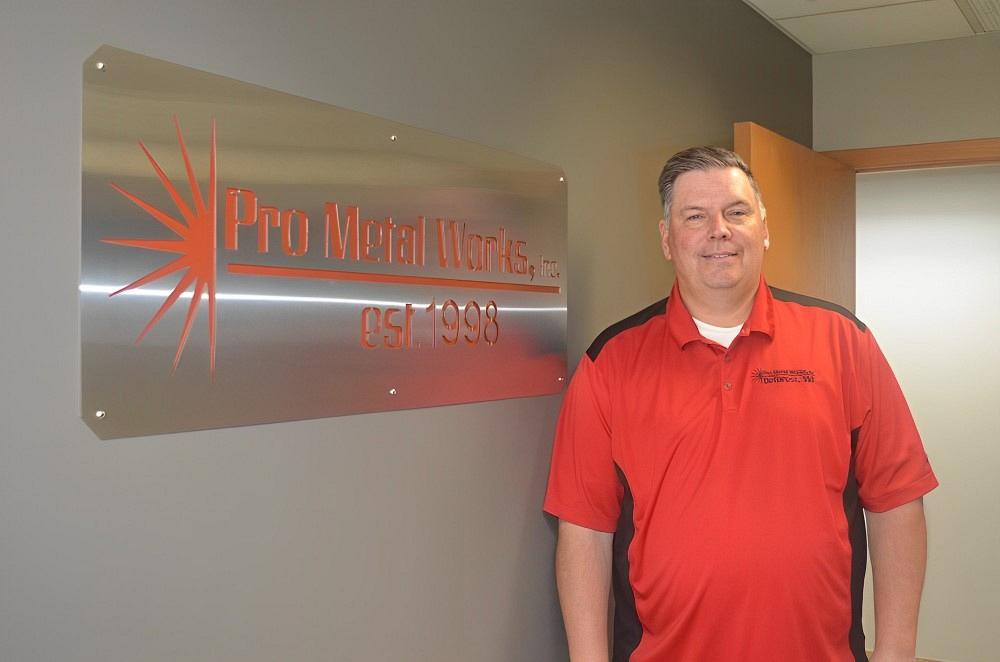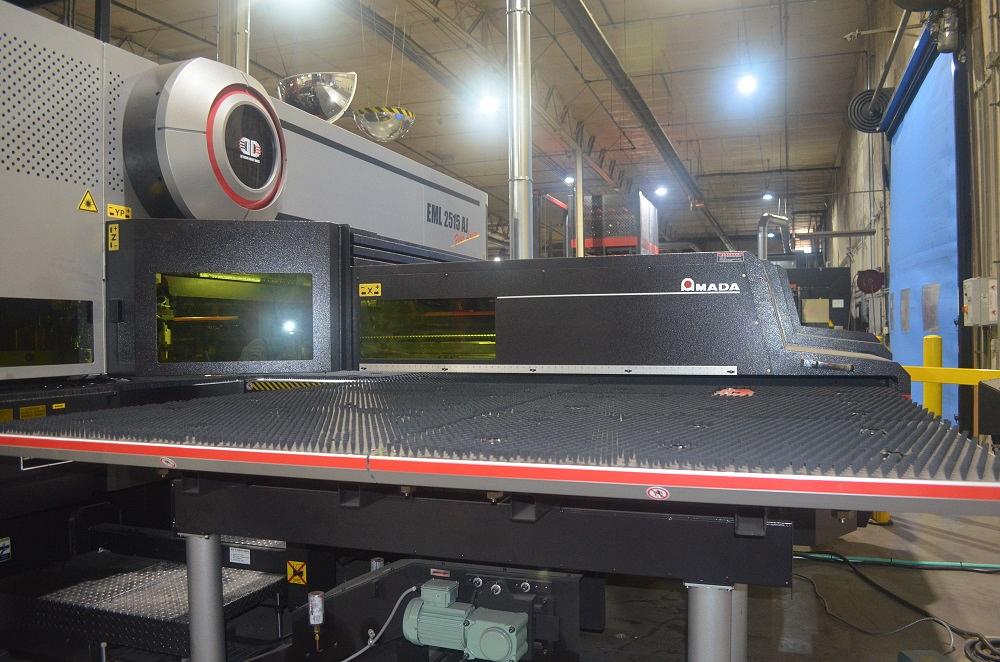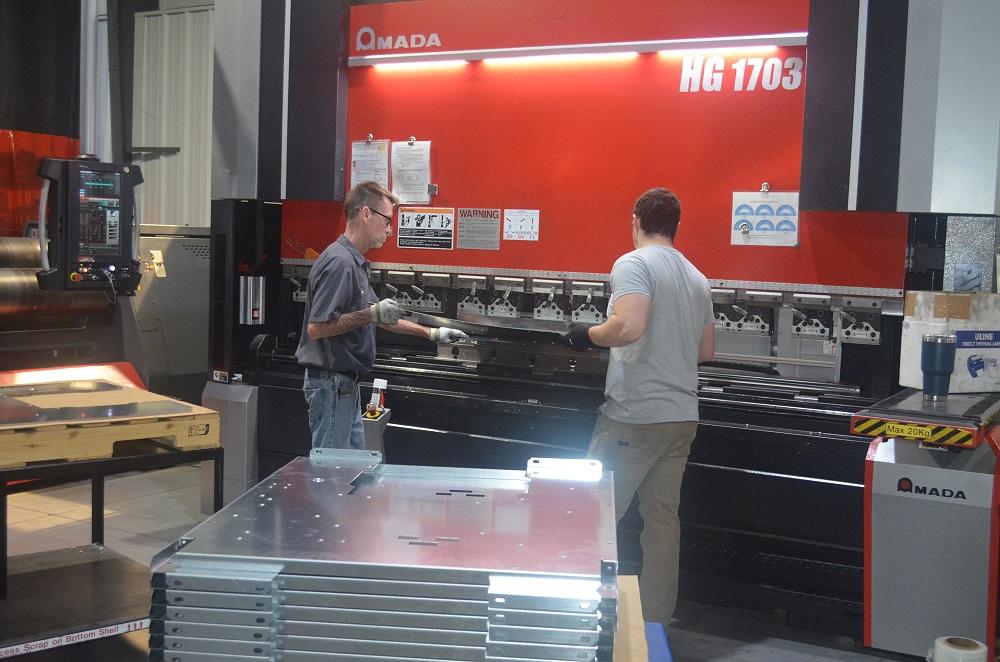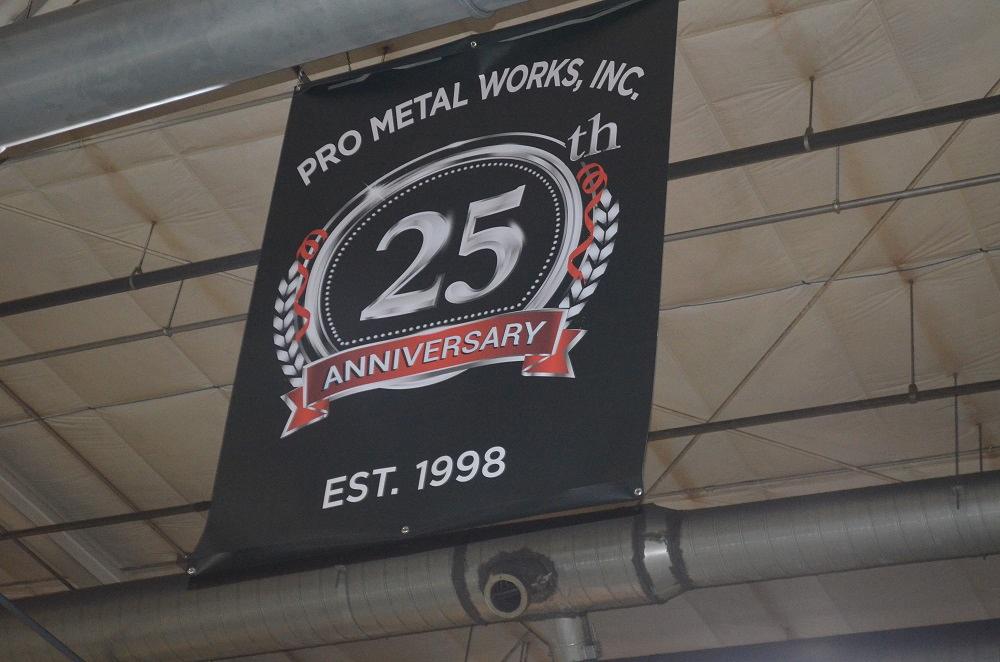Editor-in-Chief
- FMA
- The Fabricator
- FABTECH
- Canadian Metalworking
Categories
- Additive Manufacturing
- Aluminum Welding
- Arc Welding
- Assembly and Joining
- Automation and Robotics
- Bending and Forming
- Consumables
- Cutting and Weld Prep
- Electric Vehicles
- En Español
- Finishing
- Hydroforming
- Laser Cutting
- Laser Welding
- Machining
- Manufacturing Software
- Materials Handling
- Metals/Materials
- Oxyfuel Cutting
- Plasma Cutting
- Power Tools
- Punching and Other Holemaking
- Roll Forming
- Safety
- Sawing
- Shearing
- Shop Management
- Testing and Measuring
- Tube and Pipe Fabrication
- Tube and Pipe Production
- Waterjet Cutting
Industry Directory
Webcasts
Podcasts
FAB 40
Advertise
Subscribe
Account Login
Search
7 lessons for succeeding in metal fabricating
After 25 years fabricating metal parts for others, Tom Carroll shares some of the lessons he has learned in building a successful business
- By Dan Davis
- August 11, 2023
- Article
- Laser Cutting

Tom Carroll started Pro Metal Works 25 years ago in a 2,000-sq.-ft facility. Today, his DeForest, Wis.-based shop is just over 70,000 sq. ft. and is filled with a roster of fabricating equipment, most of which has been purchased in the last six years.
Tom Carroll liked the metal fabricating business, especially if he could be in one place longer than a day. Twenty-five years later, that decision seems to have been the right one.
Carroll started life in the industry selling tooling to fab shops in Wisconsin, Illinois, Minnesota, North Dakota, and South Dakota. He later added the title “product specialist” to his resume, but the schedule remained roughly the same. Get on a plane on Sunday, make calls in the territory, and head home on Friday.
One of the common points of conversation that Carroll had with numerous metal fabricating customers was if he knew of any other shops that could help with overflow work—jobs that the metal fabricator was having trouble getting to in a timely manner. That always stuck in the back of his mind, particularly as he was thinking about starting a family.
After getting married and welcoming children into the world, Carroll decided he didn’t want to spend so much time away from the house. “Running your own business allows you to do the kind of things you want to do,” he said.
The years of spending day after day on the road were enough. In 1998, Carroll and his in-laws bought a turret punch and a press brake and set up shop in a 2,000-sq.-ft. space in Waunakee, Wis., that he now describes as “the dungeon.” He called on his old metal fabricating shop contacts to see if they had any extra work to farm out. With a few successful phone calls, Pro Metal Works was on its way.
“Once the foundation was set, I just kept calling on customers,” Carroll said. “Finally, we landed a big laser cutting contract, but I didn’t have a laser. So, we had to find a new building, which we did, and then we purchased our first laser. Then things just blew up from there. We increased business that first year with a laser by 400%.”
That 3.5-kW CO2 laser cutting machine changed the trajectory of Pro Metal Works and set the tone for the following years. It would soon outgrow its new 13,000-sq.-ft. building—more on that later—but with the growth came new opportunities. In fact, growth has been pretty consistent over the lifetime of Pro Metal Works. Today, the company has $19 million in annual sales, and Carroll believes that it can accommodate even more growth with its current roster of about 50 employees and its equipment.
As Carroll talked about his 25 years in business, he had a clear understanding about what has helped his Pro Metal Works be successful over the years. Here are seven lessons that have made a difference.
1. Efforts to Retain Employees Are Worth It
Honestly, finding the right employee mix always has been a challenge for metal fabricating companies. The limited labor pool of today undoubtedly makes it more difficult.
Carroll said people never just walked in the door in search of work, but he didn’t really have to hustle like he does today. Back in the early days, he could run a classified ad in the local newspaper, work with a temporary employment agency, or just ask friends if they knew anyone interested in a job in metal fabricating. That seemed to work.

The AMADA EML 2515 AJ is one of three punch/laser combination machines at Pro Metal Works, all of which have automated material load and unload systems and material storage towers.
So while Pro Metal Works, like everyone else, struggles to find new workers, it has done well in retaining the ones it has. Carroll said that late in 2022 as he was reviewing year-end stats, he found that average time of service at his company was 7.56 years, which takes into account five new employees that joined the company that same year.
“I think that’s pretty good for a company that’s not that old,” Carroll said.
Carroll is proud of the benefits offered by his company. He pays out bonuses for meeting quality and safety metrics, and there’s also a holiday bonus. With recent business growth, employees have seen another bonus that has been up to 10% of annual wages. A 401(k) contribution is made, even if the employee is not making personal contributions, and a profit-sharing contribution is made to the 401(k) as well.
In terms of work schedules, people have the luxury of enjoying long weekends. The first shift works four nine-hour days and a four-hour morning on Fridays, and the second shift works four 10-hour days. (Automation plays a big role in the success of this schedule because work is being done but it does not require someone to be there, unless something interrupts laser cutting, such as a part flipping up and colliding with a laser cutting head.)
2. Engaging With Employees Is Also Important
“I have great people working for me, which makes things a lot easier,” Carroll said.
In describing the relationship with his employees, Carroll talked about having an “open-door” policy to listen to people’s work concerns or even their personal issues. He wants people to know that he wants to help them because they contribute to the overall success of the company.
Pro Metal Works has monthly meetings where people can ask questions, but the big group might not be the best setting for someone who might be shy. That’s why Carroll said he wants people to feel at ease in communicating with him.
To encourage that, he said that employees are consulted about new investments. For instance, the company installed a new ERP system earlier this year, and the feedback from the shop floor has been helpful in deciding what to tweak and what they need to work on. It’s been a big evolution as the move was made from whiteboards that tracked material to a completely digital system. Not only did employees help with reorganizing racking to free up space in the 77,000-sq.-ft. facility, it was instrumental in proving out the new digital material tracking capabilities. Labels are being created for work-in-process, and machine operators are scanning those labels when their process is complete, giving their downstream colleagues an idea that the job is heading their way and the material will be where it should be, which wasn’t always the case when operators had to manually input job status into the system and they would sometimes forget.
“I’m not saying that I’m going to change things or that I agree with you, but I will listen to you. If you have a good idea or want to make a change, we’ll definitely look at that,” Carroll said. “I think they value that because their voices are heard.”
Seeing is believing too. Because Carroll knows how to run the equipment, he can go out there and help out if someone needs to attend to something else outside of work.

Pro Metal Works’ AMADA 9-kW ENSIS fiber laser cutting machine not only has an automated material load and unload system, but it also has a TK 3015L automated parts sorter to eliminate the need to hire people to shake and brake parts out of a laser-cut skeleton.
3. Automation Makes the Difference
Twenty-five years since Pro Metal Works was founded, metal fabricators still follow many of the same rules used to fabricate parts for customers. The tools have changed dramatically, however, enabling companies to do much more with fewer employees. Carroll has not been surprised by this technological evolution in the shop.
“Back in the day, the CO(sub)2 laser was the king, and now everybody has fibers that are four to five times faster than a CO2,” he said. “These new machines, they’re not cheap, but you have to keep up with the Joneses.
“That’s the biggest thing that I’ve done, and that’s what I learned when I sold tooling and machines,” Carroll added.
He purchased his first Vipros King punching machine in 2001. But it was in 2005 when he really understood the impact of what automation could mean for the company.
That was the year that Hurricane Katrina hit the Gulf Coast. Although plenty of the news coverage focused on New Orleans and the massive rebuilding that would be necessary for the city to recover, the hurricane also decimated large parts of Alabama, Mississippi, and Florida. All of those areas, without power in the days after the storm, needed generators. In the days that followed, that meant that generator manufacturers needed assistance with metal fabricating services.
Pro Metal Works ended up with one of those contracts. Carroll said that’s when he ordered his first punch/laser combination machine with the automated material loading, unloading, and storage.
“There’s no way we could have kept up with the work without it,” Carroll said. The ability to run lights-out production proved to be a tremendous advantage during this time of incredible demand for generator parts.
Pro Metal Works now has three automated punch/laser combination machines, with the latest one purchased last year, an AMADA 3-kW EML AJ model. He also has two fiber lasers, the most recent being an AMADA 9-kW ENSIS machine that not only has automated material handling, but also automated part sorting. Carroll said that the shop is learning what parts make the most sense to run with the parts sorter (because you want to ensure that parts can be picked up consistently during unmanned shifts), but when they have the right balance of jobs and parts sizes, the parts sorter is “really fast.”
He added that he knows he’ll be able to take on more business without necessarily adding employees. The automation provides him with additional manufacturing capacity that doesn’t require additional operators.
4. Things Run Better When Equipment Runs as Expected
When people see investments being made in new equipment, Carroll said he believes that they see that as investment in their futures. They know the equipment isn’t cheap, and as long as the machines are running, they have a good shot at keeping customers happy with quality parts delivered on time.
Carroll credits his maintenance technician and the individual machine operators with staying on top of OEM-suggested preventive maintenance tasks. For machine operators, such tasks might be required on a daily basis.
Carroll said that he views an operator’s willingness to take care of the metal fabricating equipment as reciprocating behavior. Carroll strives to treat everyone with respect and dignity, and the employees in turn are mindful of taking care of the company’s major investments.
“You wouldn’t want me to come to your house and start banging on your fridge,” Carroll said, jokingly.
The work to create an environment where people can share their thoughts and expect a response also has helped, according to Carroll. He referred to press brake tooling and how a brake operator will take care of the tooling instead of just throwing it into a tool drawer, perhaps cracking it, and then later just tossing it because of the defect. Not only is the company out tooling, but when that particular tool is needed for a bending job and it’s not there, the job has to be halted until the right tool can be ordered for the job.
“Getting employees to be open about that stuff has helped the way we operate immensely,” he said.
5. Quality Parts Keep Customers Coming Back
Advanced fabricating equipment and an engaged and experienced workforce are key ingredients for turning out quality parts. Pro Metal Works knows this because they track it.
Carroll said that as of early summer, the company had a 12-month rolling defective-parts-per-million rate of 337. “To me, that’s world class,” he said.
6. Diversification Smooths Out Tumultuous Economic Times
It can be difficult for a young business owner to turn away business, especially if a customer is looking for a lot of metal fabricated parts. But the sooner that shops can learn about the benefits of a balanced customer portfolio, the more likely they might be around to celebrate significant anniversaries down the road.
“My main rule is never to have one customer be more than 20% of our revenue. I just won’t go beyond that,” Carroll said.
That’s why Pro Metal Works has a full-time salesperson that spends some of his time trying to prospect for new customers in underserved manufacturing sectors. Carroll said such diversification helps the business to avoid wild swings in activity, because while customers in one sector might be down, other customers might be busy.

Racking is strategically organized by material type, thickness, and size. Not only is material electronically organized to keep track of the entire metals inventory, but whiteboards at the end of each rack also give forklift drivers a visual clue as to what is kept in each rack.
If Carroll ever doubted this customer diversification strategy, he only needs to think about a one-time area competitor that had an overwhelming majority of its fabricating business tied to just one customer. That company is no longer in business.
7. When Building, Consider Space for the Future
No one is blessed with a crystal ball, which would be mighty handy when it comes to running any kind of business. But sometimes the advice of others can provide guidance that can be looked upon as some sort of modern fortune telling.
Carroll said that the one lesson he wishes he could have shared with his younger self is to “always start with a bigger building.” When he first started in his 2,000-sq.-ft. shop, he could have easily used double the space shortly after moving in. When he moved into a 13,000-sq.-ft. building, he thought it would last him 10 years; it lasted five years.
He and his brother-in-law built Pro Metal Works’ current home in 2006, but he left room for future expansion. That came in 2015 with a 30,000-sq.-ft. addition that brought total space up to 72,000 sq. ft. Even though they planned for a possible expansion, Carroll admitted that he wished he had that from the outset.
That’s how plans are. You can make them, but that doesn’t mean that things will go accordingly. But if those plans are built on solid principles, the outcome is likely to be a good one. Pro Metal Works is a good example of that.
About the Author

Dan Davis
2135 Point Blvd.
Elgin, IL 60123
815-227-8281
Dan Davis is editor-in-chief of The Fabricator, the industry's most widely circulated metal fabricating magazine, and its sister publications, The Tube & Pipe Journal and The Welder. He has been with the publications since April 2002.
Related Companies
subscribe now

The Fabricator is North America's leading magazine for the metal forming and fabricating industry. The magazine delivers the news, technical articles, and case histories that enable fabricators to do their jobs more efficiently. The Fabricator has served the industry since 1970.
start your free subscription- Stay connected from anywhere

Easily access valuable industry resources now with full access to the digital edition of The Fabricator.

Easily access valuable industry resources now with full access to the digital edition of The Welder.

Easily access valuable industry resources now with full access to the digital edition of The Tube and Pipe Journal.
- Podcasting
- Podcast:
- The Fabricator Podcast
- Published:
- 04/16/2024
- Running Time:
- 63:29
In this episode of The Fabricator Podcast, Caleb Chamberlain, co-founder and CEO of OSH Cut, discusses his company’s...
- Trending Articles
Tips for creating sheet metal tubes with perforations

Supporting the metal fabricating industry through FMA

JM Steel triples capacity for solar energy projects at Pennsylvania facility

Are two heads better than one in fiber laser cutting?

Fabricating favorite childhood memories

- Industry Events
16th Annual Safety Conference
- April 30 - May 1, 2024
- Elgin,
Pipe and Tube Conference
- May 21 - 22, 2024
- Omaha, NE
World-Class Roll Forming Workshop
- June 5 - 6, 2024
- Louisville, KY
Advanced Laser Application Workshop
- June 25 - 27, 2024
- Novi, MI




























